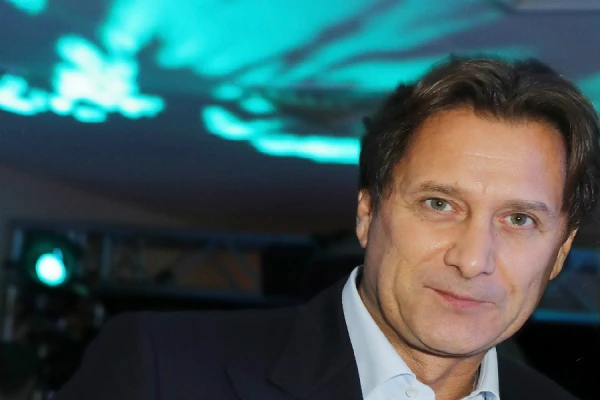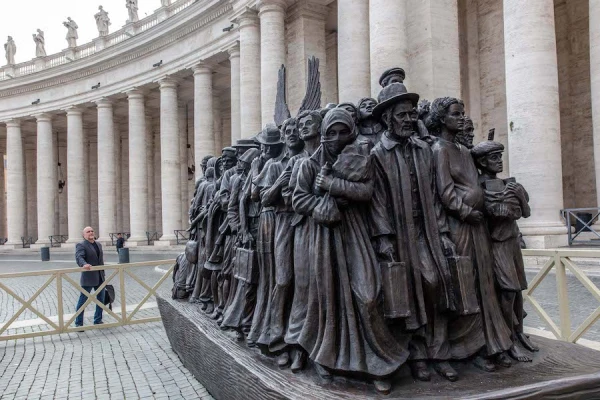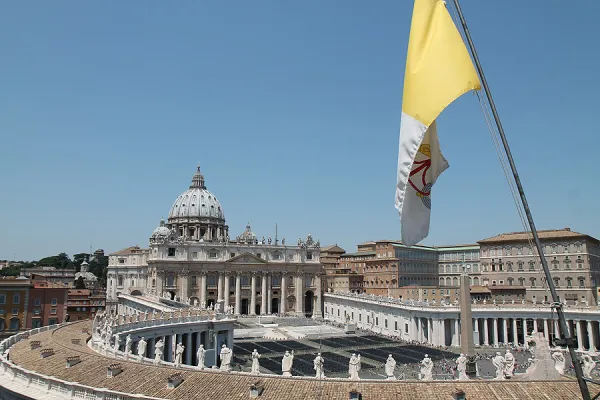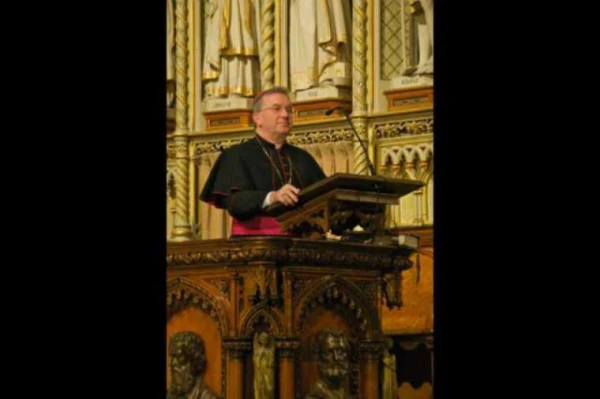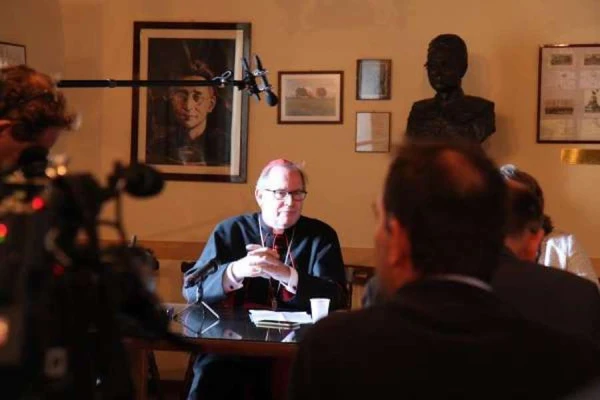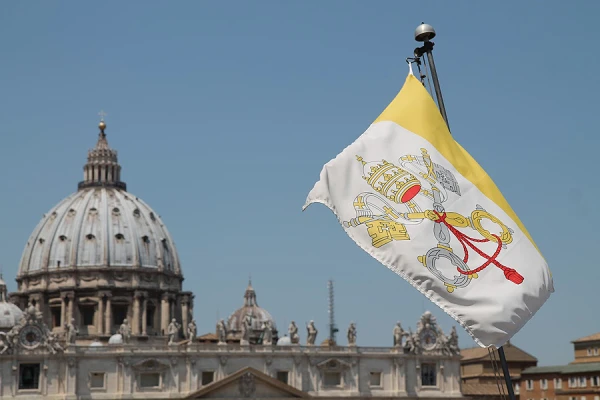
Vatican City, Dec 16, 2019 / 03:40 pm (CNA).- On Oct. 1, Vatican police raided the usually quiet offices of the Vatican’s Secretariat of State. They packed up documents, computers, and files, and banned employees from entering the premises. Since then, security and financial officials have resigned their positions, the Vatican has been excised from an international intelligence organization, and the details of a series of investments involving shady figures and banks, violations of canon law, and myriad holding companies and investment funds have emerged.
Still, the Vatican’s unfolding financial scandal has not yet led to action at the Vatican. To understand why, it’s important to understand something about the scandal itself.
In fact, there are a few scandals.
The first involves the Vatican Secretariat of State’s 2015 role in the purchase of a bankrupt Italian hospital. That scandal includes Vatican funds borrowed illicitly and transferred from religious orders to holding companies, obtaining a $25 million grant under false or misleading pretenses, and a scheme to “repay” a portion of the grant by “crediting” the grantees against requests for money in the future.
The second scandal involves a London real estate development into which the Vatican’s Secretariat of State invested hundreds of millions of dollars. The affair involves borrowing money from a discredited Swiss bank, concealing loans on internal balance sheets, violating the canonical status of a London parish, and giving 60 million in management fees to a man who sold the property to the Vatican through several of his own companies.
That man, Italian Rafeal Mincione, is a long-time figure in Vatican finances. He previously had a “beneficial ownership” in a company specializing in high-risk options trading, which was sanctioned and fined by the SEC in 2015.
Other figures connected to the project have been investigated for financial corruption and money laundering, and seen their companies suspended by financial officials.
The third scandal involves a fund, Centurion Global, by which the Secretariat of State has invested tens of million of dollars into Hollywood films, energy projects, and European startups. That investment, which has lost money while its managers have recouped millions in fees, involves fund managers connected to a Swiss bank that ran afoul of regulators and was shuttered – the same bank that partially financed the London deal. The fund does its business with an unlikely pair of banks: both linked to a billion-dollar Venezuelan money laundering and bribery scandal.
As those details emerged, one U.S. Church official asked CNA, “Haven’t these guys heard of Goldman Sachs or JP Morgan? Why are they doing business with these shady characters?”
The question is a fair one. The Vatican’s financial partners are unusual choices for a sovereign state.
The scandals are serious, and the issues they raise are proven, not speculated. They represent more than a bad deal: They represent hundreds of millions in lost investments, and a story of Vatican officials willing to bend or ignore rules in financial dealings. In the aggregate, they also represent a pattern that several popes have tried to address, with little success.
Still, while causing major repercussions in the international financial security community, the scandals have not seemed to lead to any serious consequences for Vatican officials.
Investigations are underway, and Pope Francis has said the Oct. 1 raid is a sign that accountability protocols are having an effect. He’s asked for patience as that work continues. There could indeed be indictments in Vatican City courts, though they’re expected only to impact low-level Church bureaucrats.
Seasoned experts say they’re skeptical about accountability for high-ranking officials, because the scandals point to serious structural and systemic problems at the Vatican. Pope Francis, at the time of his election, recognized in the Vatican’s dicasteries a culture lacking policy compliance, mission integration, internal controls, accessible information, and external accountability.
The pope set Cardinal George Pell to the task of reforming some elements of that culture, but well before Pell returned to Australia in 2017 to face abuse charges, the cardinal’s efforts had begun to seem Sisyphean. Cabinet-level officials in the Vatican created workarounds and carve-outs to avoid Pell’s oversight, one had cancelled Pell’s planned PriceWaterhouseCoopers audit of Vatican finances, and the cardinal reportedly found papal support for his efforts to be inconsistent.
Since Pell’s departure, the financial management office he oversaw has wielded ever less influence over financial affairs, and is no longer considered likely to effectively change operational practices at the Vatican.
But to many observers, those structural and systemic problems are the scandal. Officials acting unilaterally are seemingly able to borrow and invest hundreds of millions without oversight or internal checks. Spending caps and thresholds are an ordinary part of financial control, and are even established by canon law for dioceses and religious orders, but seem to be functionally non-existent at the Vatican.
Those familiar with financial administration say that the Secretary of State arranging for a loan that runs contrary to international convention, or a second-tier official in his office establishing the mechanisms of large-scale investment and development, with no controls to subject his action to review, illustrate precisely the problem. Especially, experts say, when the Vatican’s business partners seem consistently disreputable, and themselves mired in scandal.
An American financial expert speculated to CNA that anywhere but the Vatican, “people would be in prison by now.” In the world of the Vatican, that is unlikely.
While some observers seem nonplussed by the financial scandals, characterizing coverage of them as conspiratorial and “lurid,” Pope Francis himself has emphasized their significance. Last month, the pope admitted corruption in the Vatican, called the London development issue a “scandal,” and said that officials “have done things that do not seem ‘clean.’”
The pope’s view, expressed frequently, has been that the problem of corruption, wherever it’s found, is not principally a problem of politics or economics, but of morality, and requires the will to do things differently than they’ve been done before.
The pope has also recognized what financial criminals, grifters, and regulatory agencies have already recognized: that the Vatican, absent internal controls, transparency, and accountability, and run by well-meaning figures trained in theology, not international business, is easily taken advantage of, and has, in fact, been frequently taken advantage of.
The long history of financial scandals involving the Vatican does not make for easy reading; even the Vatileaks cables, and the bond and bank scandals of the 1970 and 1980s are a sufficiently discouraging picture of the problems caused by the culture of internal fiefdoms and the lack of internal controls at the Apostolic See.
Commentators, even those without practical Vatican experience, need only review the history of recent decades to understand why Pope Francis has repeatedly called for transparency and accountability, and why there seems to be so much difficulty getting there.
The pope also seems to recognize the effect that ongoing financial scandals have on the faith of Catholics, and on the morale of those practicing Catholics already discouraged by the 2018 sexual abuse scandal.
The reformers who have tried to clean up Vatican finances have mostly resigned or been defeated. They’ve been thwarted by cultural sclerosis, but also by a cultural tolerance for financial mismanagement that enables bad decisions to become worse ones. The Church’s teaching is clear: the stewardship of ecclesiastical goods is a sacred trust; the Church’s money is not hers, but the Lord’s.
Still, the moral obligations of financial stewards seem not to deter some Vatican officials, and some, including high-level officials, have made the excuse that as long as money is serving good purposes, how it is managed hardly matters.
The pope may yet be able to accomplish some policy changes that lead to greater financial accountability. It seems unlikely that lay Catholics will effectively call the Church to account for financial mismanagement, or effectively insist on the importance of acting with integrity with God’s resources. This means that change, regrettably, is only likely to come through European banking regulators, financial crimes investigators, and lawsuits. It will be a pity if that is the only way things move forward, but it will not be a surprise.
While the recent past has been characterized as “opaque,” the Church seems unlikely to learn about transparency, until she learns the hard way.
 […]
[…]



